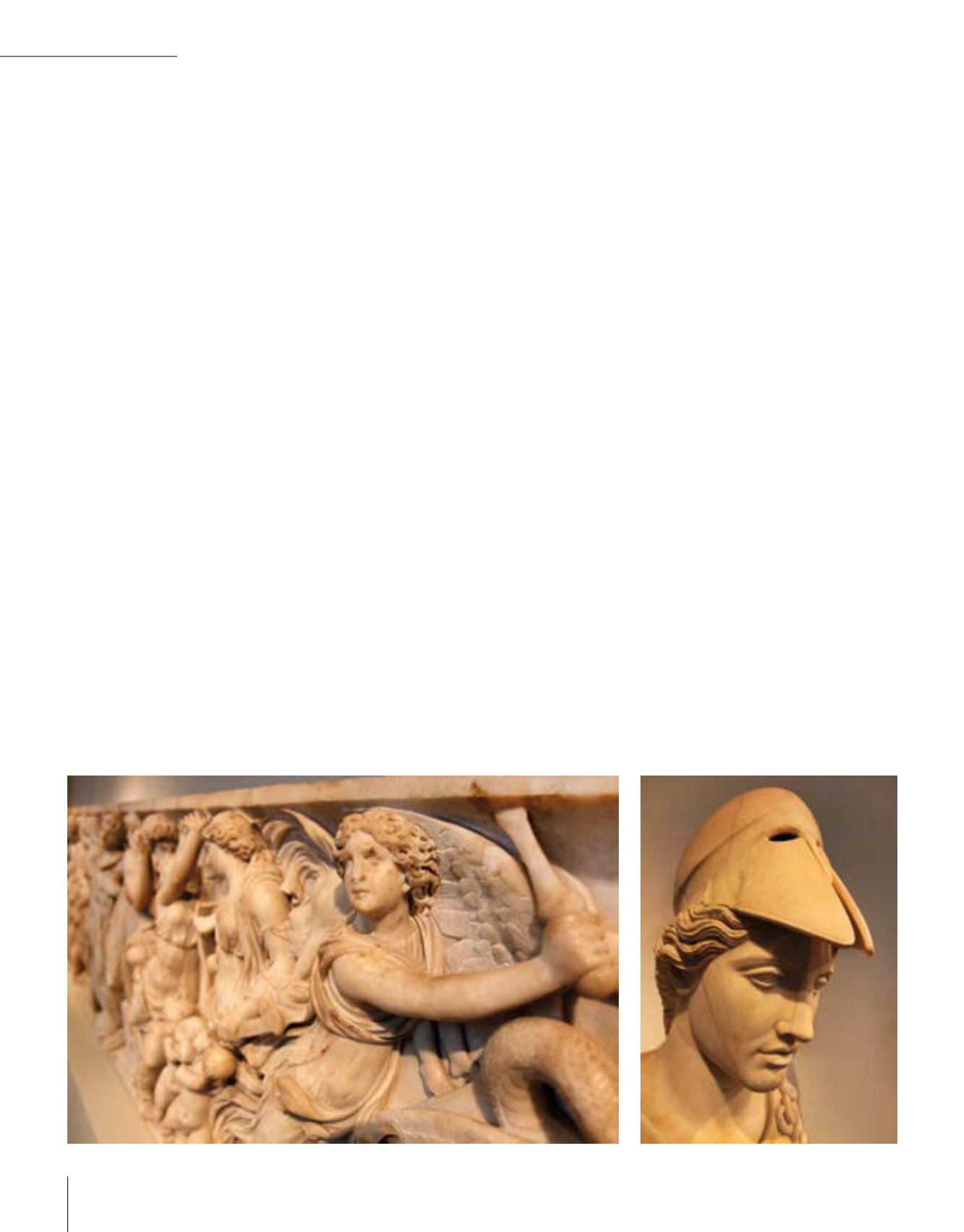
88
uzaktaki yakın
so far so close
Sunağı. 1871 tarihinde yol
yapım bahanesiyle bölgeye
gelen arkeoloji meraklısı bir
Alman mühendisin parça
parça sökerek yurt dışına
kaçırdığı biliniyor. Türkiye
Hükümeti, bu eserlerin iade
edilmesi konusunda Almanya
Hükümeti’ne başvurmuş
durumda ve ümitsiz gibi
görünse de süreç devam
ediyor. Müze yılda yaklaşık
850,000 kişi tarafından ziyaret
edilmekte.
Bergama Zeus Sunağı
malumunuz antik Pergamon
şehrinde M.Ö. 2.yy’da
Pergamon Krallığı’nı yöneten
Attalos hanedanı tarafından
yaptırılmış, mermerden
anıtsal bir dinsel yapı. At
nalı biçimdeki yapı Bergama
Akropolü üzerindeymiş.
Şimdilerde Bergama’da
temelleri kalmış durumda.
35,64 m genişliğinde 33,4
m derinliğindeki yapının ön
tarafında bulunan merdivenler
20 m genişliğinde. Dünyadaki
en önemli ve en iyi bilinen, en
iyi korunmuş antik yapılardan
biri olan sunağın dış cephesi
ve iç mekanlarında bulunan
mermer kaplama üzerindeki
freskler sanat tarihinin en
önemli yapıtları arasında
sayılıyor. Dış cephe freskleri
Antik Helen dünyasının
Olimpos tanrıları ile devler
(Giant) arasındaki savaşı, iç
alandaki freskler Pergamon’un
kuruluş söylencesi olan
Telefos’u anlatıyor.
Görsellerine iç geçirerek
sadece internetten bakmak
durumundayız çünkü Zeus
Sunağı 2019 yılına kadar
restorasyona alınmış
durumda. Bunun için biraz
bekleyeceğiz belki ama tabi
sadece bununla sınırlı değil
Anadolu’dan kaçırılanlar.
Mesela; Milet’in Pazar Yeri
Kapısı... Yapı, 120-130 yılları
arasında, İmparator Hadrian
döneminde inşa edilmiş.
Adından da anlaşılacağı
üzere, Milet şehrinin Pazar
Yeri Kapısı. Zamanla, çeşitli
depremler neticesinde yıkılmış.
Alman Arkeolog Theodor
Wiegand, 1903 yılında
yapıyı bulmuş. 1907-1908
yıllarında ise, 750 tonluk yapı,
müttefikimiz tarafından parça
parça kaçırılmış. Kimileri, yine
“Türkiye’de kalsa idi zaten
korunamazdı” gibi düşüncelere
kapılabilirler. Ama unutmayalım
ki Milet Kapısı, Celsus
Kütüphanesi’nin ön yüzünün
kardeşi. Efes Ören yerinde,
Celcus Kütüphanesi pekala
be among the most important
pieces in terms of art history. The
exterior façade frescoes depict
the war between the Gods of
Olympia and the Giants, whereas
the interior frescoes depict the
myth of Telephus which is a
myth on the establishment of
Pergamon.
All we can do is look at its
photos online, because the Altar
of Zeus will be undergoing a
restoration until 2019. We have
to wait to see this, but of course
it is not the only piece that was
smuggled out of Anatolia. Let
us consider Market Gate of
Miletus... This structure was built
during 120-130 under the rule of
Emperor Hadrianus. As its name
suggests, it is the Gate of the
Marketplace in the city of Miletus.
It has been demolished over time
due to various earthquakes. The
German archeologist Theodor
Wiegand has unearthed this
structure in 1903. The 750 ton
structure was then smuggled
out of our country piece by
piece during 1907-1908. Some
people might think, “it would not
be well-preserved if it remained
in Turkey”. But let us not forget
that the Market Gate of Miletus
is the sister of the front façade of
the Celsus Library. The Celsus
Library stands tall and is still in
place at the archeological site
of Ephesus, attracting hundreds
and thousands of tourists every
year. When we consider the
issue from the perspective of
displaying the artworks, wouldn’t
it be very impressive to have it
on display at its original location
just like the archeological site of
Ephesus? This structure would
be the second Celsus Library of
Ephesus in Turkey if it was not
smuggled out. It really drives
you mad.
Another structure is the Gate
of Ishtar. This time it is from
the lands of our neighbors, but
still from the Ottoman Empire.
Located on the city walls of
ancient Babylon, in today’s Iraq,
this giant brick gate consisting
of two monumental entrances
separated by an inner courtyard
and opened up to the main
street known as the “Ceremonial
Road”. It was ordered to be built
in 575 B.C. by the Babylonian
King Nebuchadnezzar the 2nd
in the name of the Goddess
Ishtar and connects the inner
and outer city walls of Babylon
as the eighth gate of the city
which was the capital of the New
Babylonian State. Its beauty and
workmanship are striking when
we consider the year in which it
was built. It is a tangible work of
art straight from the fairy tale city
of Babylon. It looks as if it just
popped out of a fairy tale with
lion figures, daisies, dragons etc.
Unfortunately it is not difficult to
imagine what would happen to
this piece if it remained in Iraq.
Hundreds of glazed tiles have


